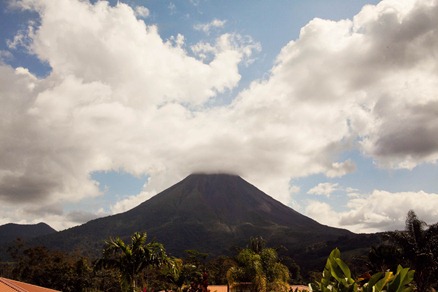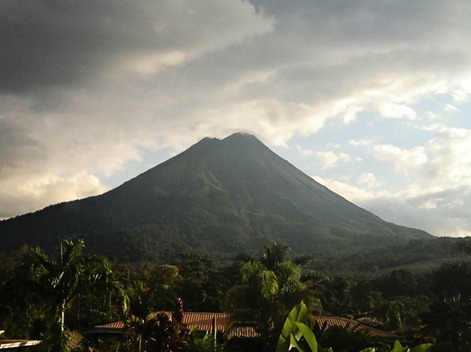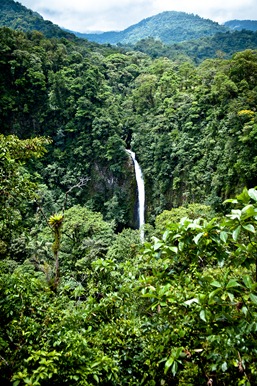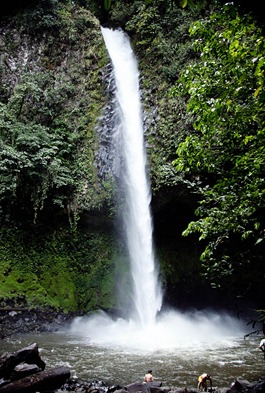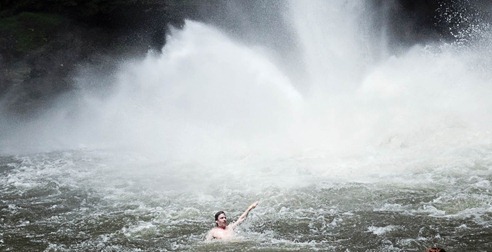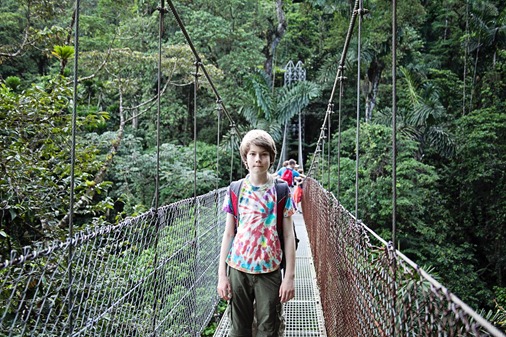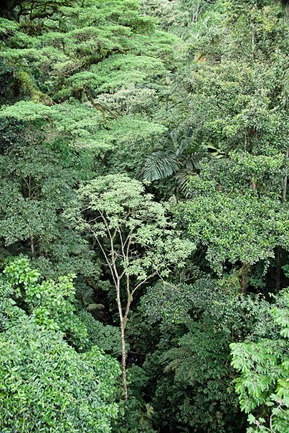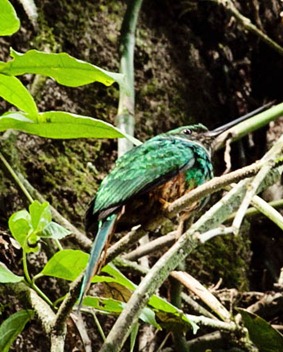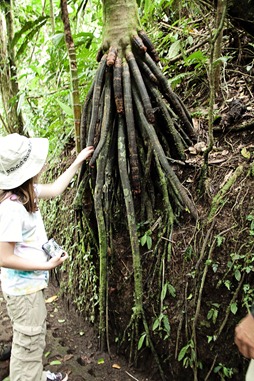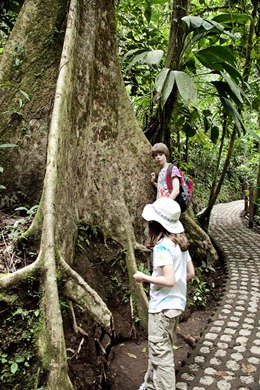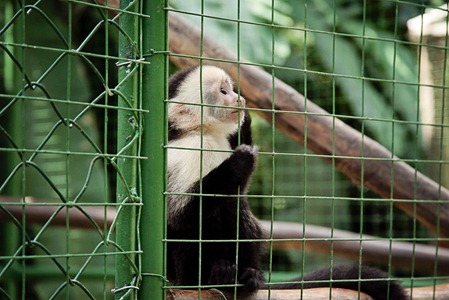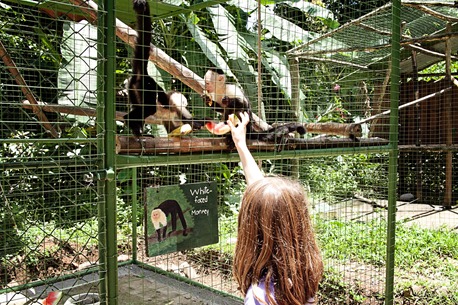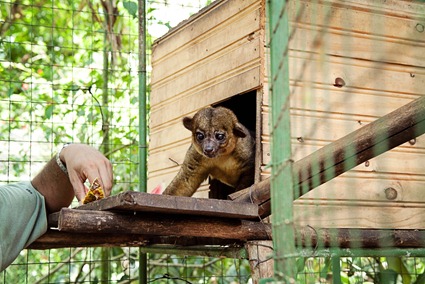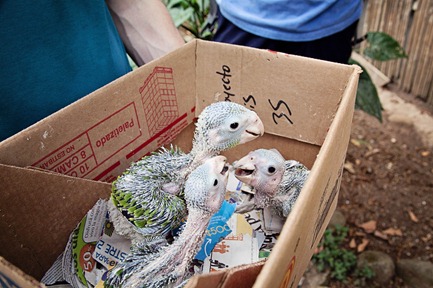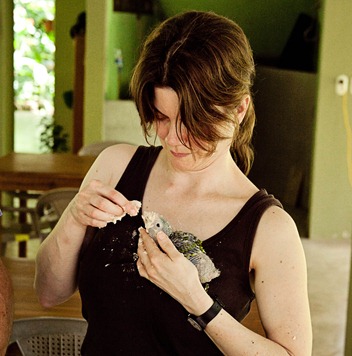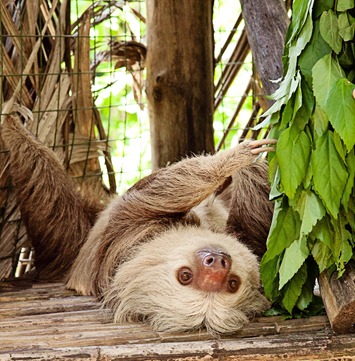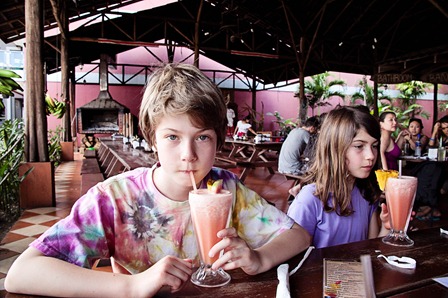Did we ever have a great time in Costa Rica. It has it all: natural beauty, wildlife, friendly people, good food, great weather.
We started our trip in Arenal, in North central Costa Rica. Arenal is fairly temperate – it has rainforests but the weather was (relatively) cool, around mid 70s most days. What is unique about Arenal is the volcano, which rises rather dramatically up from the surrounding plain. Unfortunately for us, the volcano went quiet a little over a year ago, so there was no lava viewing. In light of this knowledge, I nearly decided to skip Arenal in favor of another destination within Costa Rica. However, I’m really glad we went – there was so much to do and see in the area.
Since I mentioned the volcano, here it is fully visible which only occurred twice during our two and a half day stay. The clouds hugged the top of the volcano from early morning until late afternoon:
I would almost give up on ever seeing it, but then magically, about an hour before sunset, the clouds would drift off and the top would be revealed, only to be quickly covered by clouds again. Imagine seeing it at night with orange lava streaking down the side. It might be hard to see from these pictures, but the right side of the volcano is covered with year old lava, while the left side is still covered with forests!
On our first full day in Arenal, we started the day with a hike down to La Fortuna waterfall. This is one of the main tourist attractions in the area and there were a number of tour buses in the parking lot by the time we left. It was the only time in Costa Rica when I felt overwhelmed by the number of tourists. The hike down to the base of the waterfall was ridiculously steep and with a line of people both descending and ascending, it made for slow going.
The top of the waterfall:
And the bottom…
A few (brave?) individuals swam out to the waterfall’s base, recognize the one below?:
Apparently, the water was not only cold, but the current also quite powerful.
That afternoon, we went for a hike at Arenal hanging bridges, a park with a 3 km long hike across 20 hanging bridges of varying lengths and heights.
Here’s Cole on one of the higher hanging bridges:
The view looking down from the same bridge, notice how far above the canopy we were:
We hired a guide, Hansel, who was so talented at finding wildlife. It also didn’t hurt that he brought a powerful pair of binoculars. During the course of the hike, we saw 8 different types of colorful birds (including hummingbirds and toucans!), a poison dart frog, spider monkeys, peccaries (kind of like a small boar without the tusks), a pit viper, coatimundi, and lots more. Here’s a picture of the world’s largest hummingbird (it’s about the size of a robin):
The flora was also quite interesting in terms of the adaptive ability of some of its plants– these are the roots of a walking palm tree (which moves about 3 or 4 feet a year):
And a bloodroot tree which apparently ‘bleeds’ red sap.
At the end of the hike the guide had a fresh fruit platter prepared for us with Costa Rican pineapple and watermelon which we ate while watching the sunset on the volcano. Not too bad, eh?
On our second day, we drove over to Proyecto Asis, a wild animal rescue center, one of seven such centers in Costa Rica. It’s run by Alvarao, the son of the center’s original founder and their mission is to reintroduce animals captured from the wild. The animals often come to them from the police, who run random searches of highway traffic in order to prevent such illegal trade (we encountered one of these random searches ourselves). The people who run the center were wonderful – warm, knowledgeable, and very passionate and dedicated to their mission. Our visit to the center also included care and feeding of some of the animals. I’ll include a few of these below:
A white faced capuchin
I have to admit, it was a bit depressing to see animals in cages, like in a zoo, but apparently if they aren’t contained, they will wander away. Social animals, like monkeys, can only survive in groups, and so in order to reintroduce them back into the wild the center has to find a monkey troop that will accept them, which is very difficult. If the animals wander off, they will die before long.
We did get to feed the animals which is something you cannot do to animals in the wild (for good reason). And though we saw many monkeys in Manuel Antonio, we never got this close to any of them!
A kinkajou…
Alvaro brought out a box of baby macaws which turned up during a police seizure of illegally captured animals. Apparently, the macaws sold in pet stores here are nearly always obtained illegally. They will sell for $10,000 each in the US and are big business in Costa Rica, as you can imagine.
I got to feed one of them and it was a difficult, messy business! Apparently the mother macaw pries open the baby’s mouth and then stuffs the food down their throats. Let me tell you, this was really tiring to do. They do not want to open their mouths, even though they are hungry! I ended up with more of the food on my shirt than down my chick’s mouth. After half an hour of this, I was exhausted and ready to throw in the towel.
My favorite part of our visit was getting close to this guy. This is a two toed sloth which is the more common of the sloths to be spotted in Costa Rica. They are also the most active. While we saw quite a few two-toed sloths in the wild, they are very shy and during the day are usually curled up on some high branch. They have the sweetest faces, and he just looks so relaxed, doesn’t he?
After our visit, we headed back to the hotel to relax and hit the pool. In the evening, we took in one of Arenal’s signature activities – a visit to a natural hot springs, heated by the nearby volcano’s geothermal activity. No pictures from the hot springs, because the photographer deserves some time off, right? But it was phenomenal. We went to Eco Termales, a family run springs, with all natural landscaping set into the forest. There were a number of pools, waterfalls, sprinklers, etc. We bought some ice cold lemonades and just chilled (or should that be warmed?).
The next day it was off to Manuel Antonio, the second leg of our journey. I’ll be posting on that soon, but I thought I would leave you with a picture of the kids drinking smoothies at a Soda – a typical outdoor eatery that serves only Costa Rican food. Although Costa Rican food is simple, it’s quite delicious, not to mention cheap, so we ate quite a bit of the local cuisine on our stay.
